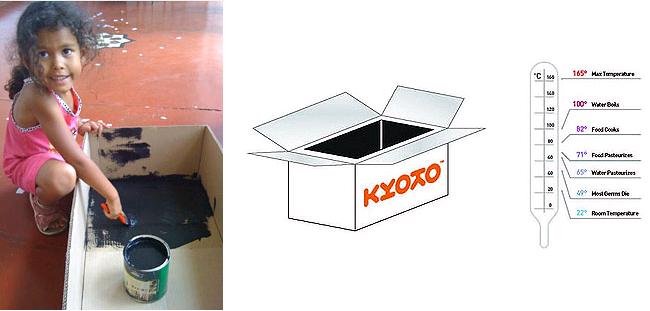
Inhabitat: Think humankind discovering fire was revolutionary? How about a cardboard box that uses the sun’s rays to cook without burning firewood? That’s precisely what the Kyoto Box, a cardboard solar cooker, can do. Made out of basic, 5th-grade-science-experiment type materials, the Kyoto box solar cooker offers a life-altering solution for thousands of people: the ability to cook and heat water without burning wood. So how does it work? Inventor John Bohmer says the box uses “the greenhouse effect for something good.”
The Kyoto Box consists of two cardboard boxes, one which Bohmer’s own 5-year-old daughter helped him paint black, and another covered with tin foil to help concentrate the sun’s rays. A plexiglass cover is used to trap heat inside making it possible for the box to boil and bake, but not fry, so it is arguable that it is healthy as well. The Kyoto Box is already in production at a factory in Nairobi, and Bohmer hopes to offer a the box in a recycled plastic form in the future. The cost of the box will be a mere 5 euros.
More information can be viewed here.
$6 Solar Cooker Wins $75K Climate Change Prize [Inhabitat]en
Kyoto Box Solar Cooker
(Visited 227 times, 1 visits today)
Those of us who have worked for years to promote awareness of solar cooking are thrilled at the prize won by Jon Bohmer for his solar cooker. The publicity it has generated will help raise the profile of this simple, powerful and renewable technology.
It is however, not a ‘new invention’.
The cardboard solar box cooker, for which Mr. Bohmer won $75,000 from the FT Climate Change Challenge is a variation on one of the many designs that have been freely available to the public for years on Solar Cookers International’s archive http://solarcooking.org/
The archive website contains extensive data on the design, construction, dissemination and international use of solar cookers to reduce carbon emissions and deforestation.
After logging on to the SCI web archive, users can click on build a solar cooker. There they will find detailed plans for a variety of cardboard, wood, metal and plastic solar box cookers, solar panel cookers and solar parabolic cookers.
Solar cooker advocates like Mr. Bohmer who have been inspired by the many designs currently available often come up with new variations and post them to our website where they can be shared with the rest of the world.
The solar box cooker is the oldest type of solar cooker. It was first widely promoted by two American women who were among the founders of SCI in 1988. Our organization was initially know as Solar Box Cookers International. Another of SCI’s founders, Robert Metcalf has been traveling the world for decades teaching people how to build and use solar cookers not only for cooking but also for solar water pasteurization.
When refugee populations in Africa began expanding in the early 1990s and access to cooking fuel and clean water became a serious problem for these people, a cheaper, smaller, more portable version of the cardboard box solar cooker was developed by Roger Bernard. Tens of thousands of these have been made and sold or given away.
Almost all solar cooker projects are currently funded by small non-profits. There is little to no government funding available. And yet many governments continue to subsidize the purchase of bottled cooking gas by up to 50% and the charcoal trade is destroying the forests of Africa and south Asia. This must change.
The largest solar cooker project currently underway is in three Darfur refugee camps in Chad. The women in those camps have manufactured and distributed more than 30,000 cardboard and aluminum foil Cookits. Trips outside the camp to gather firewood have been reduced by 86%.
THANK YOU very much to both Steve Teo and Patricia Mcardie for your informative posts. I recently read the Elisabeth Rosenthal NYT article about ‘black carbon’ and since I live in Laos, am well aware of how hazy and smoggy the air becomes once February and March rolls around. This year in particular was quite bad although the haze started later. It accelerated in March due to swidden agriculture and irresponsible burning of waste. So, how would I get these solar cookers to SEA? Would love to see it being used there since most Lao still use coal or wood burning stoves!
Thanks, once again!
Dear Patricia at solarcooking.org.
You may not have intended it, but your post tends to undermine John Bohmer and rather than simply promoting yourself, you sound as if you are trying to take credit.
Everyone with basic science understands the greenhouse effect and the basic use of reflective material to focus sun rays, and I’m sure John Bohmer didn’t need your website to tell him this.
The designs on your website appear to be of reflective material only, while Bohmer’s box uses black to enhance absorbtion. It also uses the principle of insulation as well as a plexiglass top. I don’t see anything remotely similar in your “build it yourself” section.
It is good to promote yourself, but next time, try to do it without sour grapes.
My Mother and I used a “solar oven” several times back in the late 1970’s. They do a good job on pork and beef roasts, though a thermometer is recommended to check the internal temp of the meat as the ovens do take longer to cook than normal.